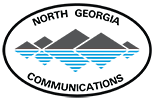DMR digital systems enable these key benefits:
Doubling of Capacity in Existing Licensed Channels
DMR enables a single 12.5 kHz channel to support two simultaneous and independent calls. This is achieved using TDMA, Time Division Multiple Access. Under TDMA DMR retains the 12.5 kHz channel width and divides it into two alternating timeslots A and B (illustrated in figure 1 below) where each timeslot acts as a separate communication path. In figure 1 Radios 1 and 3 are talking on time slot 1 and Radios 2 and 4 are talking on timeslot 2.
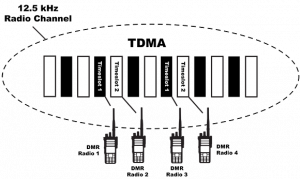
Timeslot TDMA Structure of DMR
Each communication path is active for half of the time in 12.5 kHz of bandwidth, each uses an equivalent bandwidth of half x 12.5 kHz or 6.25 kHz. This is known as having an efficiency of one talk path per 6.25kHz of spectrum. However with DMR the channel as a whole maintains the same profile as an analogue 12.5kHz signal. This means that DMR radios operate in the license holders existing 12.5 kHz or 25 kHz channels; there is therefore no need for re-banding or re-licensing but at the channel capacity is doubled. This is illustrated in diagram 2 below.
This TDMA approach to increasing call capacity in a given bandwidth is very well tried and tested. TETRA and GSM cellular mobile – two of the world’s most widely adopted two-way radio communication technologies – are TDMA systems. The US public safety radio standard, P25, is also currently evolving its Phase II specifications to two-time slot TDMA.
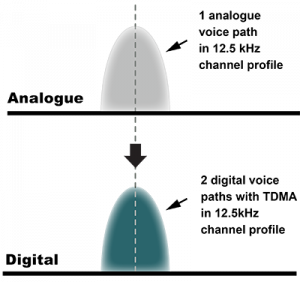
Analog to Digital Migration with DMR Systems
FDMA, Frequency Division Multiple Access, an alternative approach to increasing capacity splits 12.5 kHz or 25 kHz channels into two or more discreet 6.25 kHz channels. Theoretically radios working in 6.25 kHz FDMA are able to squeeze two new channels side by side in an old 12.5 kHz channel.
The practical reality falls short of this. In many countries no specific 6.25 kHz licenses exist and the regulatory regime does not permit a license holder to operate two 6.25 kHz channels in an existing 12.5 kHz license. It is usually possible to operate with a single 6.25 kHz radio channel within a 12.5 kHz license but this gives the user no increase in capacity. This situation is illustrated in figure 3 below.
In the United States, where 6.25 kHz channels are licensed, license holders have not been permitted to sub-divide existing 12.5 kHz licenses into multiple 6.25 kHz channels. To increase capacity for 6.25 kHz FDMA systems, users have to seek new 6.25 kHz licenses in other areas of the spectrum.
There remains a difficulty in jurisdictions where users are allowed to squeeze two 6.25 kHz paths into an existing license. Operating a system at one site using two channels that are adjacent to each other in the spectrum is well known to create a risk of interference. So for this reason users would still most likely want to obtain a new license in another area of the spectrum to increase capacity with a 6.25 kHz FDMA solution (see figure 4 below). In contrast because DMR’s two TDMA paths fit neatly into the existing channel structure, no new interference issues will be encountered when DMR systems are installed.

Analog to Digital Migration with 6.25kHz FDMA Systems

Analog to Digital Migration with 6.25kHz FDMA
In summary both FDMA and TDMA systems used in digital PMR/LMR protocols are theoretically equally spectrum efficient but the TDMA approach used by DMR brings the advantages of compatibility with the existing license regimes in place around the world and does not introduce new interference issues.
One potential advantage of the FDMA 6.25 kHz approach is that you do not need a repeater to co-ordinate TDMA timeslots to deliver two independent talk paths as is necessary for DMR. (DMR systems do work well without repeaters and still deliver the many benefits inherent in DMR systems such as reverse channel signaling, but not two fully independent channels per 12.5 kHz of spectrum). Without a repeater, however, all radios need to be in range of each other at all times to get a predictable doubling of capacity with FDMA. So if the system needs a repeater for extra range, or to cover a problem area, now or in the future (e.g. with a site move or the opening of a new location) this benefit of FDMA is of limited value. DMR systems also have the advantage that 12.5 kHz signals are more robust to interference than 6.25 kHz signals. This means that in noisy environments a signal on a 12.5 kHz channel is less likely to be degraded than a 6.25 kHz signal and so will be more likely to give an acceptable level of service to a radio user.
The non-repeater advantage of 6.25 kHz FDMA systems for capacity increase is only beneficial where:
the site is small and at all times for the lifetime of the system all users radios will be in direct range of all others users
the frequencies required have been obtained because splitting an existing license into multiple 6.25 kHz channels will not be an option for regulatory or interference reason
cost or availability of more robust 12.5 kHz channel licenses is an issue
there is no need to have compatibility with legacy 12.5 kHz analogue systems (see below)
DMR, which was developed from the start with long term business needs in mind, does not have these constraints.
Backwards Spectrum Compatibility with Legacy Systems
License holders may need to keep hold of existing licenses to ensure backwards compatibility with their own legacy radios or with an external organization’s analogue system. As DMR uses 12.5 kHz channels the required spectrum compatibility is built in. This is illustrated in below.

Compatibility of DMR Spectrum Channels with Legacy Analog Systems
Efficient Use of Infrastructure Equipment
With DMR TDMA you get two communications channels with one repeater, one antenna and a simple duplexer. Compared to FDMA solutions, two-slot TDMA allows you to achieve 6.25 kHz efficiency while minimizing investments in repeaters and combining equipment. The required equipment of the two approaches for a simple system is shown below.
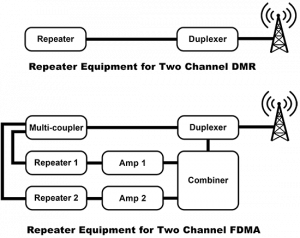
Equipment Required for Two Channel FDMA and TDMA System
FDMA requires a dedicated repeater for each channel, plus expensive combining equipment to enable multiple frequencies to share a single base-station antenna. There can be further costs in making combining equipment work with 6.25 kHz signals and there’s typically a loss in signal quality and range when it’s used in this way. This in turn gives rise to a need for power amplifiers shown in figure 6.
With FDMA 6.25 kHz systems there is a lower tolerance for errors introduced by the phenomenon of oscillator aging and resulting signal drift away from the desired centre frequency by the transmitting radio. This results in less robust adjacent channel protection, making the system vulnerable to interference. Specialized equipment; a high stability oscillator can be introduced; but at a cost. In contrast, two-slot TDMA achieves stable two-channel equivalency using single-channel equipment. No extra repeaters or combining equipment are required (and there is lower drain on air conditioning and less back up power supplies needed at a repeater site).
Longer Battery Life and Greater Power Efficiency
Maximizing battery life has always been one of the great challenges for mobile devices with limited options for increasing the talk time on a single charge. Since an individual call on two-slot TDMA only uses one of the two timeslots it requires only half of the transmitter’s capacity. The transmitter is idle half of the time; whenever it’s the unused timeslot’s “turn”. Using the example of a typical duty cycle of 5 percent transmit, 5 percent receive, and 90 percent idle, the transmit time accounts for a high proportion of the drain on the radio’s battery. By cutting the effective transmit time in half, two-slot TDMA can enable up to 40 percent improvement over analogue radios.
(One manufacturer’s published product literature gives a talk time of 9 hours operation for analogue mode but 13 hours for digital mode on the same radio). DMR digital devices can also include sleep and power-management technologies that increase battery life.
Many factors affect power consumption in an individual device. When using published battery life figures for widely marketed DMR and FDMA digital radios data shows that for each hour of usage the TDMA require between 19% and 34% less battery capacity than the FDMA models. Choosing a technology with lower energy use gives more flexibility as well as environmental benefits. As communications needs grow (for example greater data requirements) more battery capacity is needed and it seems logical to move towards technology that is inherently more efficient and capable of supporting additional functions. As discussed above, DMR infrastructure is also simpler than that required for FDMA systems, therefore needing less energy. These power efficient features give DMR users a leaner and greener radio network as well as one with the benefit of long battery life on the radios themselves.
Ease of Use and Creation of Data Applications
The end-to-end digital nature of DMR means that applications such as text messaging, GPS and telemetry can be easily added onto radio devices and systems. DMR standard also supports the transmission of IP data over the air enabling the easy development of standard applications. This offers a higher potential return on your investment. For many one of the key drivers for switching to digital is to add business enhancing data services and applications to radio systems.
The doubling of channel capacity that DMR implementations achieve is also key to adding data applications. To maintain existing voice service quality it is necessary to have extra capacity for data traffic. This can be particularly important for applications such as Automatic Vehicle Location where a very large number of messages can be generated by the system to keep locations continually updated. Although this can be a highly valuable tool to the business user, extra capacity will most probably need to be provided if voice services are not to be negatively impacted. DMR implementations deliver the extra capacity required simply and cleanly.
![]()
Location Based Services with a DMR System Tracking User Locations
Flexibility Through Simultaneous Use of TDMA Channels
While voice is using the first time slot then the second time-slot can, in a TDMA system, be used for transmitting application data such as text messaging or location data in parallel. This is useful, for example, in dispatch systems that provide both verbal and visual dispatch instructions. This is enhanced data capability is becoming increasingly important in data rich environments.
The future roadmap for two-slot TDMA applications includes the ability to temporarily combine both slots to effectively double the data rate to 9.6 kb/s, or to use both slots together to enable full-duplex, phone call like, private calls. FDMA radios cannot deliver these capabilities without the expense of adding extra transceivers and using additional licensed channels. This is because in a single 6.25 kHz FDMA channel there is one communication path; only person can talk, but not two, or you can transmit voice or data, but not both and the data rate is limited to the 4.8 kb/s that can be squeezed down a single 6.25 kHz channel.
Advanced Control Features
The DMR standard allows for the ability to use the second time-slot for reverse-channel signaling – that is, instructions in the form of signaling being sent to the radio on the second time slot channel while the first channel is in a call. This enables priority call control, remote control of the transmitting radio, or emergency call pre-emption and gives precise control and flexibility to the operator of a radio system. FDMA systems cannot deliver similar functionality because they are limited to one path only per spectrum channel.
Superior Audio Performance
DMR digital technology provides better noise rejection and preserves voice quality over a greater range than analogue, especially at the farthest edges of the transmission range. This is because a great deal of effort was put into selecting Forward Error Correction (FEC) and Cyclic Redundancy Check (CRC) coders when developing the standard. With these coders receiving radios detect and automatically correct transmission errors by analyzing bits to detect errors. The DMR standard specifies over 14 different coders to be used, each matched to different types of traffic. Through the use of coders and other techniques, digital processing is able to screen out noise and re-construct signals from degraded transmissions. Users can hear much more clearly — increasing the effective range of the radio solution and keeping users responsive to changing situations in the field.
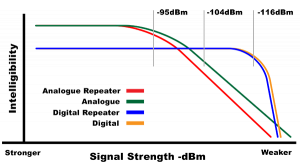
Range Improvement with DMR Compared to Analog
There is some debate about which digital system gives the best coverage; a 12.5 kHz or a 6.25 kHz channel based system. Both have advantages and disadvantages. 6.25 kHz based systems are disadvantaged because when you squeeze multiple high power transmissions in 6.25 kHz channels into the spectrum, it is necessary to limit the modulating signal of each transmission quite tightly; in technical terms reduce the signal deviation; so as not to cause interference in the next channel along in the spectrum. This limit on the signal deviation means the receiver is less able to distinguish whether it is being sent a one or a zero when the signal is weak – i.e. at the edge of the system’s range. This, in theory, impacts the coverage of 6.25 kHz systems.
Some regulators will also limit the power of repeaters used in 6.25 kHz FDMA systems to 50% of that available to a 12.5 kHz DMR system, where a user wishes to operate two 6.25 kHz repeaters in a given 12.5 kHz of spectrum. This is carried out to ensure that overall power levels are maintained per unit of spectrum. Such restrictions may also impact range. DMR systems also benefit from superior implementation of Forward Error Correction protocols. FDMA systems do, however, benefit from the fact that with a 6.25 kHz channel there is a lower noise floor than with a wider 12.5 kHz channel.
Security of Supply Through a Fully Open Standard
DMR is a fully public open standard backed by a wide variety of vendors meaning that buyers can be assured of continuity of supply. There are many examples of the success of open standards because this encourages wide ranging supplier participation. More suppliers results in more choice for users, more rapid product development and lower prices from competitive pressures. Today DMR is the most widely adopted digital two way radio system, in active use in over 100 countries and is the market leading digital DMR technology.
MOTOTRBO™ is Motorola’s proprietary trade mark name for its portfolio of products based on Digital Mobile Radio (DMR) Standards. Contact us for more information.
